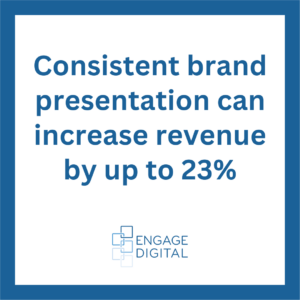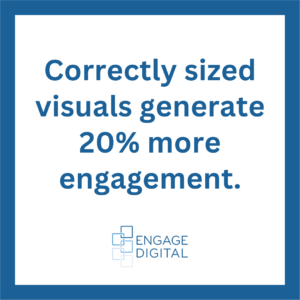In our increasingly digital world, the power of visual content in marketing becomes increasingly apparent. Creating an engaging online presence involves several aspects, from choosing the right color palette to maintaining consistent branding. This guide aims to provide you with key insights and strategies to help you effectively enhance your visual content on social media platforms.
Color choices can significantly impact how your brand is perceived. Moreover, maintaining constant branding not only increases recognizability, but also trustworthiness among your followers. Correctly sized visuals play a pivotal role in overall content performance, while the right typography can significantly influence the effectiveness of your message. Meanwhile, user-generated content and infographics present information more digestibly, leading to enhanced audience engagement. Join us as we delve into these aspects and more.
Choosing the Right Color Palette
The significance of color in your visual content cannot be downplayed. Varied hues stir different emotions and associations, subsequently influencing how your audience perceives your brand. Thus, selecting a unified color palette is crucial. It not only bolsters your brand’s identity but also contributes to a picturesque feed.
For instance, a vast body of research suggests that specific colors perform better on social media platforms. In fact, a study by the University of Missouri-Columbia found colors greatly impact consumers’ attitudes toward brands. A popular choice for business-oriented content is blue, which is associated with feelings of trust.
In contrast, vibrant and warm colors like red and orange are often used for promotional materials. These colors are known to evoke excitement and energy. It’s also pivotal to note that bright and intentional content is the best way to captivate consumers. After all, they typically form subconscious judgments about products and services within just two minutes.
Color is integral to visual content, affecting your audience’s perception and establishing your brand’s identity. Strategically harnessing color can paint your brand in a light that resonates most with your target audience. After all, the proper color selection boosts brand recognition by 80%, according to research by the Pantone Color Institute.
Maintain Consistent Branding
In the realm of social media, consistency equates to recognizability and trustworthiness. Hence, maintaining a steady brand presence on your audience’s feed is vital. This steady presence can be achieved by using distinct fonts, logos, or stylistic elements that remain constant across all social media platforms.
 Notably, developing a social media brand style guide greatly enhances consistency. This guide, primarily a reference for content creators, social media managers, and designers, is instrumental in preserving uniform visuals. It provides them with the tools to visually represent the brand in a consistent, appealing way across various platforms.
Notably, developing a social media brand style guide greatly enhances consistency. This guide, primarily a reference for content creators, social media managers, and designers, is instrumental in preserving uniform visuals. It provides them with the tools to visually represent the brand in a consistent, appealing way across various platforms.
However, a well-rounded style guide should go beyond just a color palette, logo, and fonts. It should also include essential elements like brand icons, imagery, and tone of voice, among others. Incorporating these elements will ensure a more comprehensive, holistic representation of your brand.
According to a study by Lucidpress, consistent brand presentation can increase revenue by up to 23%. Therefore, implementing a coherent style guide for your visuals doesn’t just ensure a sophisticated appearance on social media but can also significantly impact your bottom line. In essence, brand consistency isn’t just an aesthetic choice in the digital world – it’s an operational necessity.
Optimize Image and Video Sizes
Contrary to popular belief, sizing is pivotal in the overall performance of images and videos on social media platforms. Each platform comes with specific size requirements for visual content. Meeting these size mandates ensures your content appears as initially intended, enhancing overall user experience.
To underscore, oversized or pixelated visuals may discourage engagement. On the other hand, optimally sized content can considerably augment user engagement. In a sense, correct sizes cater to the aesthetic sensibility of users, thereby contributing to a more pleasant browsing experience.
Interestingly, research by Social Media Examiner highlights that correctly sized visuals generate 20% more engagement. This denotes the importance of familiarizing oneself with platform-specific guidelines. Algorithmically, social media platforms tend to prioritize images that stick to these best practices and recommended formats.
Size optimization isn’t just about aesthetic appeal, but it also has a direct impact on user engagement. The benefits extend beyond visibility to improved algorithmic performance, underscoring its importance in practical social media management.
Optimize Video Content
Videos are integral to enhancing social media engagement, with Facebook accounting for over 4 billion daily video views. Recent trends have shown that short-form videos, in particular, hold sway across various platforms. Platforms like TikTok and Instagram Reels testify to this phenomenon, indicating that precise and entertaining content is the key to capturing user attention.
Purely in terms of duration, it’s advisable to keep videos under 60 seconds. This allows you to maintain viewer interest and deliver your core message promptly. The ability to deliver noteworthy content amongst an onslaught of information can significantly influence user engagement and conversion rates.
Furthermore, a study by Livestream reveals that live videos generate six times more interactions than regular pre-recorded videos. This makes leveraging live videos a potential game-changer for your strategy. Think along the lines of hosting Q&A sessions or showcasing product launches and behind-the-scenes glimpses – since such content often incites a sense of urgency, prompting users to engage.
Never underestimate the power of first impressions. Therefore, allocate adequate time to designing compelling thumbnails. They can significantly impact a video’s click-through rates and are often instrumental in determining the success of published videos.
Choose Fonts Wisely
The choice of typography in your social media graphics can significantly influence your message’s effectiveness. It’s imperative to select fonts that align seamlessly with your brand’s personality. Additionally, ensure that your fonts maintain readability across diverse devices.
For consistency, it’s advisable to limit your use of diverse fonts. Cluttering your graphic design with an excessive variety can steal away from the professional look and feel intended for your content.
Typography has two primary purposes in graphics:
- To promote legibility.
- To help communicate the tone and sentiment of a design piece.
According to a study in the International Journal of Advanced Computer Science and Applications, visually appealing typography improves user perception by 50%. This includes fonts with superior readability, like sans-serif fonts such as Arial and Helvetica, which are favored for their clarity on digital screens.
Engage through Infographics
Infographics provide a unique blend of visuals and information, serving as a vehicle for complex data transmission. As attention spans continue to decrease, the need for creative methods of relaying information becomes paramount. Luckily, infographics fill this gap – they present data in a palatable, easy-to-grasp format.
Interestingly, infographics have emerged as a favorite go-to medium for both Millennials and Gen Z, as they facilitate swift learning and information retention. Infographics are favored by these audiences and consistently rank among the top five most used types of content. They trail only behind social media posts (excluding videos), case studies, videos, and eBooks, according to a study by the Content Marketing Institute.
Moreover, research underlines the power of visual communication, suggesting our brains process visuals 60,000 times faster than text. Platforms like Canva and Piktochart have capitalized on this trend, offering easy-to-use tools for designing visually appealing infographics.
Leveraging infographics in your content strategy can significantly enhance user engagement. They simplify complex data and present it in a way that’s both aesthetically pleasing and digestible to your audience.
Encourage User-Generated Content
User-generated content (UGC) holds a unique position in digital content creation. UGC is made by your consumers, not your brand itself. It brings a raw, authentic touch to your social media presence, contributing to a sense of community among your followers.
Given the nature of UGC, it provides a unique perspective on your brand. Encouraging your audience to create and share graphic and video content related to your brand can offer a refreshing change from standard, brand-created content. Moreover, sharing UGC on your platforms gives your audience a sense of ownership, often leading to heightened engagement.
Interestingly, according to Stackla’s Consumer Content Report, research shows that user-generated content heavily influences 79% of people’s purchasing decisions. This is significantly higher than the impact of standard brand photos and videos. This statistic underscores the value of authentically resonating with your audience through UGC.
Fostering an environment that encourages UGC not only enriches your content inventory but also massively influences your audiences’ perception and purchasing decisions. In today’s digital age, spaces that bolster authentic conversation inevitably lead to increased conversions.
Harnessing the power of visuals on social media platforms is undeniably a game-changer in today’s digital marketing landscape. This guide has walked you through strategies from selecting appropriate colors, and optimizing your brand’s presentation, to encouraging authentic user-generated content. Implementing these tactics strengthens your social media presence and significantly influences audience perception, engagement, and ultimately, conversions. Keep these insights in mind, to create a striking, consistent, and engaging visual narrative in your future endeavors.






